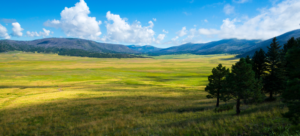
For Immediate Release: November 16, 2023
Media Contacts:
Madeleine Carey, WildEarth Guardians, (505) 417-5893, mcarey@wildearthguardians.org
Cyndi Tuell, Western Watersheds Project, (520) 272-2454, cyndi@westernwatersheds.org
Bjorn Fredrickson, New Mexico Wild, (206) 372-5608, bjorn@nmwild.org
Monitoring reveals hundreds of livestock trespassing in Valles Caldera National Preserve
Near constant illegal presence of livestock in endangered species habitat threatens protected watersheds
SANTA FE, N.M. — Data obtained from regular monitoring in Valles Caldera National Preserve reveals federal land managers have failed to stop persistent trespass grazing on sensitive wildlife habitat in northern New Mexico. These findings come more than a year after conservation groups notified the National Park Service, the U.S. Forest Service, and the U.S. Fish and Wildlife Service of their plans to take legal action over persistent illegal livestock use in the Valles Caldera National Preserve.
Livestock authorized to graze on Forest Service grazing allotments surrounding the Preserve frequently trespass into Park Service managed lands, harming habitat for native wildlife, including federally protected endangered species. In response to the conservation groups’ threat of legal action, the agencies outlined their past actions and future plans to address the problem of trespass livestock, which included fencing off protected lands on the Preserve, notifying the owners of the trespass livestock, coordinating between agencies, monitoring damage to natural resources, and enforcing range laws by taking action against the Forest Service grazing permits. Conservation groups promised to monitor, document, and report trespass livestock to the land managers.
Despite these promising negotiations, land managers have failed to coordinate on fence building and have not taken action to hold the ranchers accountable for the damage caused by the trespass livestock.
“I’m frustrated,” said Madeleine Carey, Southwest Conservation Manager for WildEarth Guardians. “What started out as promising negotiations earlier this year seem to have stalled. By allowing the continued destruction of headwater streams, the agencies have lost sight of the issue at hand and are failing in their public duty to protect fragile natural resources. Due to their inability to coordinate and cooperate, trespass livestock continue to damage waters that should be protected because they are on Park Service land.”
The groups submitted more than a dozen reports to federal land managers, documenting nearly 1000 trespass cows. These reports included photos, brand and ear tag information, and location information. The Park Service independently documented trespass livestock and has been documenting impacts to natural resources within the Preserve. According to the Park Service, each cow spent an average of five days on the Preserve, amounting to 1,855 cow days (371 cattle) on the Preserve between April and October of this year. The cattle tend to congregate in riparian areas and wet meadows where they trample vegetation, cause stream bank collapse, and pollute otherwise pristine waters.
“Trespass (unauthorized, illegal) cattle have been accessing Valles Caldera National Preserve from grazing allotments on the Santa Fe National Forest for years. It is deeply disappointing that the Forest Service and National Park Service have been unable to work together to develop a collaborative solution to this problem, despite the agencies agreeing that these cattle do not belong in the National Preserve,” said Bjorn Fredrickson, conservation director at New Mexico Wild. “It is widely understood that unmanaged grazing can result in profound ecological impacts, particularly in riparian areas. So, while resolution of this issue remains elusive to the two agencies, the trespass cattle continue to despoil headwater streams, water quality, and other sensitive resources in Valles Caldera.”
“The Park Service, the Forest Service, and the permittees have an obligation to keep livestock out of the Valles Caldera,” said Cyndi Tuell, the Arizona and New Mexico director at Western Watersheds Project. “These lands are important to the Jemez mountain salamander, the Mexican spotted owl, and the New Mexico meadow jumping mouse, creatures with very few places to call home. If the Park Service and the Forest Service can’t agree on who should build and maintain the fence, we need the Forest Service to hold the permittees accountable for letting their cows damage habitat for these imperiled species. We are tired of the foot-dragging. Ultimately, it is the rancher’s responsibility to make sure their cows stay on the allotments and out of the Preserve.”
###
WildEarth Guardians is a conservation nonprofit whose mission is to protect and restore the wildlife, wild places, wild rivers, and health of the American West. Guardians has offices in Arizona, Colorado, Idaho, Montana, New Mexico, Oregon, and Washington, and over 189,000 members and supporters worldwide.
Western Watersheds Project is a non-profit environmental conservation group that works to influence and improve public lands management throughout the western United States in order to protect native species and conserve and restore the habitats they depend on. Our primary focus is on the negative impacts of livestock grazing, including harm to ecological, biological, cultural, historic, archeological, scenic resources, wilderness values, roadless areas, Wilderness Study Areas and designated Wilderness.
New Mexico Wilderness Alliance (New Mexico Wild) is a nonprofit grassroots organization dedicated to the protection, restoration, and continued enjoyment of New Mexico’s wildlands and wilderness areas. Founded in 1997, we achieve our mission through administrative protection, federal wilderness designation, and ongoing stewardship. We have a membership of individuals from all corners of New Mexico and across the nation. Our organizing efforts span the state and involve many diverse groups, including ranchers, sportsmen, land grants, acequia communities, tribal and religious leaders, scientists, youth, and community leaders.

